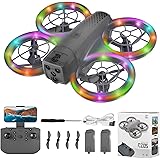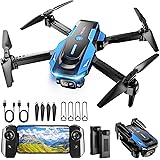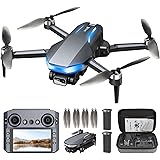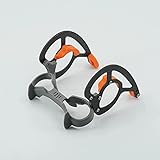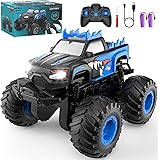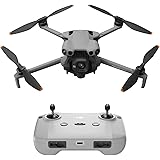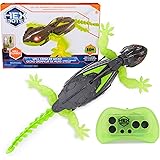The world of FPV (First Person View) drones is constantly evolving, with innovations pushing the boundaries of what these compact flying machines can achieve. In the realm of micro long-range quadcopters, one particular design, originally pioneered by Dave C, has carved out a significant reputation. Known for its balance of light weight and endurance, this 4-inch platform has been a favorite among enthusiasts seeking extended flight times in a small package.
As you may have observed in the video above, a fascinating new iteration has emerged from Flywoo: the Hexplorer LR, a 4-inch hexacopter. This unique drone poses an intriguing question: is adding two extra motors truly an upgrade, or simply an interesting novelty? Let us delve into the details of this hexacopter, exploring its design, capabilities, and the practical implications for FPV pilots.
The Hexacopter Revelation: Why Six Motors?
The journey to the Flywoo Hexplorer LR begins with a well-established predecessor, the Explorer LR4 quadcopter. This 4-inch model has consistently been praised for its performance, making it a benchmark in its category. Yet, Flywoo decided to introduce a “magic trick” – transforming this proven design into a hexacopter. This means instead of four motors, the Hexplorer LR is equipped with six, a significant departure from the norm for micro drones.
- The most striking feature accompanying this design is the industry’s first 6-in-1 ESC (Electronic Speed Controller) in a compact 20mm form factor. For anyone looking to build a hexacopter, this integrated ESC simplifies the process immensely, as dedicated hexacopter ESCs for small builds have traditionally been scarce.
- The central question, however, remains: does this additional complexity translate into a better flying experience compared to its quadcopter sibling? This is a point that will be explored through frame comparisons, component upgrades, and, crucially, flight performance assessments.
Frame Dynamics: Hexacopter vs. Quadcopter
When examining the frames of the Hexplorer LR hexacopter and its quadcopter counterpart, it is noted that the core design philosophy remains largely intact. The top plate, a testament to the original Dave C design, shows minimal changes. However, the bottom plate has undergone specific modifications to seamlessly integrate the two additional arms, secured with a robust Y-shaped base and two screws per arm.
Weight Matters for the 4-inch Hexacopter
One of the most immediate and impactful differences between the two designs is their dry weight:
- The quadcopter version weighs in at 165 grams.
- The hexacopter version is a heavier 210 grams.
This increased weight carries significant implications, especially for pilots aiming to stay under the crucial 250-gram regulatory limit, a common ceiling in many regions to avoid stricter drone registration requirements. Achieving a decent flight time with a battery while staying below this threshold becomes a considerable challenge for the hexacopter. It is like trying to pack a powerful V6 engine into a compact car; while it adds power, the added weight can easily push you over the desired limit.
Thrust Potential: More Motors, More Power?
On the surface, the hexacopter boasts 50% more motors than the quadcopter, which suggests a theoretical 50% increase in thrust. This immediately brings to mind images of enhanced power and lifting capability. Imagine two vehicles, one with four tires and another with six, attempting to pull a heavy trailer. The six-wheeled vehicle, with its greater contact patch and distributed load, would naturally have an advantage in hauling capacity. However, raw thrust does not always equate to a superior overall flight experience, especially when factors like efficiency and handling are considered.
Major Upgrades in the Hexplorer LR
Beyond the mere addition of motors, the Flywoo Hexplorer LR introduces several substantial upgrades over its quadcopter predecessor. These improvements are not merely cosmetic; they represent significant enhancements in performance, reliability, and user convenience, some of which are hoped to be rolled back into future quadcopter versions.
Enhanced Flight Controller: F7 Power for Your 4-inch Hexacopter
A crucial upgrade in the hexacopter is the transition from an F4 to an F7 processor on the flight controller. While an F7 processor is inherently faster, its primary benefit here lies in its abundance of UARTs (Universal Asynchronous Receiver-Transmitters). Think of UARTs as dedicated communication channels for different components on your drone. The F4 processor, having fewer UARTs, often necessitates using a “soft serial” port for certain functions, such as the DJI On-Screen Display (OSD).
Soft serial ports are like a temporary, less reliable detour on a busy highway. They can lead to issues such as the OSD dropping out or freezing, which can be highly disruptive during flight. In contrast, the F7 processor in the Hexplorer LR features a generous seven hardware UARTs. This means critical components like GPS, DJI OSD, and receiver can all communicate through dedicated, robust channels, virtually eliminating the OSD freezing issues. It is like having dedicated, smoothly flowing lanes for all your vital data traffic, ensuring everything arrives on time and without interruption.
Barometer for Precision Altitude Control
Another welcome addition to the Hexplorer LR’s flight controller is an onboard barometer, or pressure sensor. While GPS is excellent for determining horizontal position, it can be surprisingly inaccurate when it comes to altitude, especially in a dynamic environment. A barometer, on the other hand, provides precise altitude data by measuring atmospheric pressure changes.
This feature is particularly vital for GPS rescue functionality. Without a barometer, a drone relying solely on GPS for altitude during rescue could waste significant energy by climbing to unnecessarily high or unsafe altitudes. The barometer ensures that GPS rescue operates efficiently and safely, maintaining a consistent return height. Furthermore, the inclusion of a barometer also means that the flight controller has a dedicated iNav target, making it simple for users to flash and run the iNav firmware, which is known for its advanced navigation capabilities.
Bluetooth Connectivity: Field Configuration Made Easy
Flywoo has also integrated a Bluetooth adapter into the Hexplorer LR, a feature that significantly enhances user convenience. Many FPV pilots find themselves in the field without a laptop, making on-the-spot configuration adjustments a challenge. With the onboard Bluetooth adapter, pilots can connect their smartphone via apps like SpeedyBee (or the Betaflight configurator app if sideloaded) to perform a full range of flight controller configurations.
This capability transforms field adjustments from a cumbersome task requiring external hardware to a quick and effortless process using a device most pilots already carry. Imagine being able to fine-tune your drone’s settings with just a few taps on your phone, much like adjusting your car’s stereo settings from its touchscreen display.
The 6-in-1 ESC: A Hexacopter Game-Changer
The star of the show for this hexacopter is undoubtedly its groundbreaking 6-in-1 ESC. Previously, building a compact hexacopter often required either multiple smaller ESCs or custom solutions, adding complexity and weight. The integrated 6-in-1 ESC is a testament to engineering prowess, offering all six motor outputs on a single, compact 20mm board.
This innovation streamlines the build process, reduces wiring, and allows for a cleaner, more reliable electronic stack. It is a specialized component that unlocks the potential for micro hexacopters, providing a dedicated solution where none existed before. This component is truly unique and enables the very existence of a 4-inch hexacopter in this form factor.
GPS Performance: Challenges and Attempts
Despite these significant advancements, GPS performance remains a common challenge in micro 4-inch builds. Pilots often experience slow satellite lock times, insufficient satellite acquisition for stable navigation, or even loss of signal mid-flight. These issues are sometimes attributed to electrical interference generated by other drone components, such as the Caddx Vista digital video system.
Flywoo has attempted to mitigate this by wrapping the GPS wires in copper foil to limit electrical interference. While a good effort, its effectiveness has been noted as minimal, especially without proper grounding of the foil. This highlights that while manufacturers are actively addressing these pain points, reliable GPS performance on micro drones is still an area of ongoing development. It is like trying to listen to a faint radio signal amidst static; while some shielding helps, fundamental improvements are still needed for crystal-clear reception.
Optimizing Your Flight: Betaflight Setup for the Hexplorer LR
The Flywoo Hexplorer LR comes with a sensible default Betaflight setup, but as with any advanced FPV drone, there is always room for personalization to optimize performance for individual flying styles and battery choices. Understanding and adjusting these settings can significantly enhance your flight experience.
Power and Battery Settings for Your 4-inch Hexacopter
For those utilizing high-voltage (HV) LiPo batteries, adjusting the maximum cell voltage from the default 4.3V to 4.4V is recommended. This change accounts for the higher charge ceiling of HV LiPos, ensuring the flight controller accurately monitors battery health. Similarly, if you plan to use lithium-ion (Li-Ion) batteries, the warning cell voltage should be lowered from 3.5V to around 3.1V or even 3.0V. Li-Ion batteries have different discharge characteristics and can safely be discharged to lower voltages (down to 2.5V without damage) compared to standard LiPos, thus allowing you to utilize more of their capacity.
Receiver and RSSI Configuration
The Hexplorer LR thoughtfully ships with AUX 8 pre-configured as the RSSI (Received Signal Strength Indicator) channel, which is ideal for setups using Crossfire or DJI. For Crossfire users, it is important to note that while it defaults to 8 channels (leaving only four AUX channels), it can support up to 12 channels. To get LQ (Link Quality) on AUX 8, you can temporarily switch your Crossfire receiver to 12-channel mode, assign LQ to channel 12 (AUX 8), and then revert to 8-channel mode. This “trick” allows you to have link quality data without the potential performance hit of continuous 12-channel operation.
Stick Low Threshold Adjustment
The default stick low threshold in Betaflight is often set at 1050, a safety measure to prevent accidental arming if your transmitter endpoints are not perfectly calibrated. However, if your transmitter’s endpoints are correctly calibrated (meaning your stick inputs range precisely from 1000 to 2000), this threshold can be safely lowered to around 1010. This adjustment reduces the “dead band” at the bottom of the throttle stick, providing a more responsive and direct throttle feel.
Custom OSD for Essential Data
For long-range flying, a customized OSD is invaluable. Essential information like GPS coordinates, altitude, cell voltage, and RSSI should be prominently displayed. While DJI’s default OSD might lack some of these details, Betaflight allows for extensive customization, ensuring all critical flight data is visible at a glance. It’s like having a personalized dashboard in your car, showing exactly the information you need, where you need it.
Failsafe and GPS Rescue: Critical Safety Settings
Configuring failsafe properly is paramount for long-range flights. One recommended adjustment is to set the RSSI channel (e.g., AUX 8) failsafe behavior from “Hold” to “Set” with a value of 1000. This ensures that upon failsafe, your RSSI value drops to 0%, providing a clear visual indication of signal loss, rather than displaying the last received value.
The hexacopter also features GPS rescue as its default failsafe. Interestingly, Flywoo has enabled the “allow arming without fix” option. This gives pilots the flexibility to arm and fly even if the minimum number of satellites (typically five or more for GPS rescue to function) has not yet been acquired. This means you can choose to fly freestyle without waiting for a GPS lock, or, if you plan a long-range flight, manually ensure a fix before takeoff. This approach balances convenience with responsibility, putting the pilot in control of when GPS rescue is truly needed.
Flight Performance: Putting the Hexplorer to the Test
The ultimate test of any drone is how it performs in the air. The Flywoo Hexplorer LR, with its six motors and unique design, presents an interesting case study, especially when evaluated against its quadcopter sibling and other specialized 4-inch drones.
Freestyle Capabilities: A Heavyweight in the Air
Flywoo’s marketing materials suggest the hexacopter has enough thrust for freestyle and to carry a GoPro. However, real-world testing, especially with a full-size action camera like a GoPro Hero 8 (bringing the total weight to approximately 550 grams with an 850 mAh 4S battery), paints a more nuanced picture. While the hexacopter can certainly get airborne, hovering requires about 45-50% throttle, indicating it feels like a “chonker” or a much heavier craft. Think of it like a heavy-duty pickup truck trying to maneuver like a nimble sports car; it has power, but it lacks the finesse for agile movements.
Aggressive freestyle maneuvers lead to noticeable battery sag and a general lack of responsiveness. The default tune might not be optimized for freestyle, resulting in a “bouncy” feel rather than the crisp, locked-in sensation desired by freestyle pilots. While it can freestyle, it does not excel at it, feeling stiff and less nimble compared to purpose-built freestyle drones.
Endurance and Carrying Capacity: Where the Hexacopter Shines
For pure, unburdened flight time, the quadcopter version of the Explorer LR still holds an edge. However, the hexacopter’s endurance was found to be about 85% of the quadcopter’s, a smaller difference than anticipated. This is particularly interesting when considering heavier payloads.
It is theorized that as more weight is added to the hexacopter – for instance, a large 3000 mAh lithium-ion pack – the efficiency gap between it and the quadcopter may decrease. This is because motors have an efficiency sweet spot; they are not most efficient at extremely low or extremely high throttle. With a heavy load, the hexacopter’s motors might operate closer to their optimal efficiency range, whereas the quadcopter’s motors would be screaming at near-full throttle, pushing beyond their efficient operating zone. This means the hexacopter could actually be a more viable long-distance cruiser when equipped with heavy batteries or a full-size action camera.
The additional power provided by the two extra motors makes a significant difference when carrying weight. If you plan to fly with a GoPro or a large battery, the hexacopter provides essential throttle headroom. This extra power can be critical for pulling out of dives, fighting headwinds on the return journey, or executing maneuvers that would leave a quadcopter struggling with insufficient power. It is the difference between a smaller engine straining under a heavy load and a larger engine handling it with more ease, offering greater reserves when needed.
Handling Comparisons: Hexplorer LR vs. Other 4-inch Drones
Comparing the hexacopter to its quadcopter sibling, the hexacopter often feels “stiffer” and “bigger” in the air, a sensation that transcends mere weight. This could be due to differences in tuning or the inherent dynamics of a six-motor configuration.
Against a dedicated 4-inch freestyle machine like the Catalyst Machineworks Shocker (which uses larger 2004 motors compared to the Hexplorer’s 1404 motors), the hexacopter falls short in handling. The Shocker is a superior freestyle ripper, offering greater nimbleness and a more durable frame for aggressive flying. While the Shocker’s larger motors provide impressive power, they do not quite match the pure weight-carrying capacity of the hexacopter’s six motors. Ultimately, the Hexplorer LR hexacopter is not the optimal choice for freestyle, but its unique benefits lie elsewhere.
Making the Choice: Is the Hexplorer LR Right for You?
The decision of whether the Flywoo Hexplorer LR hexacopter is the right choice ultimately hinges on your priorities as an FPV pilot. This drone is not merely a souped-up version of its quadcopter ancestor; it is a specialized tool designed for specific applications.
For the Enthusiast and Early Adopter
For those who are captivated by cutting-edge technology and unique designs, the Hexplorer LR’s appeal is undeniable. The presence of a 4-inch hexacopter, especially one featuring the first-ever 6-in-1 ESC, makes it a highly desirable piece of kit for the enthusiast. It represents a novel approach in the micro long-range category and is undeniably “cool” for those who appreciate innovation.
For the Long-Range Pilot with Heavier Payloads
If your primary goal is to achieve long-range flights while carrying a significant payload, such as a full-size action camera or a high-capacity lithium-ion battery, the Flywoo Hexplorer LR stands out. The increased thrust and throttle headroom provided by the six motors make a substantial difference in these scenarios. It offers the power and stability needed to confidently carry heavier setups, handle adverse conditions like strong headwinds, and still have enough reserve power for critical maneuvers. While the quadcopter excels at pure endurance with minimal weight, the hexacopter’s efficiency under load and superior carrying capacity make it a compelling option for more demanding long-range missions.
When to Consider Alternatives
Conversely, if absolute maximum flight time with minimal weight is your sole objective, the original Explorer LR4 quadcopter likely remains the superior choice. Its lighter dry weight naturally translates to longer endurance when equipped with standard batteries.
Furthermore, for pilots focused squarely on freestyle flying, the Hexplorer LR is not the ideal platform. Its handling characteristics, while providing sufficient power, do not offer the agility and responsiveness expected of a dedicated freestyle drone. In this arena, specialized 4-inch quads like the Catalyst Machineworks Shocker would undoubtedly provide a more satisfying and capable freestyle experience.
Ultimately, the Flywoo Hexplorer LR carves out a niche as a powerful, feature-rich 4-inch hexacopter, particularly well-suited for long-range cruising with heavier payloads. It sacrifices a small amount of pure endurance for a significant boost in lifting capability and throttle headroom, making it an excellent option for those who prioritize carrying capacity in their micro long-range Flywoo hexacopter.


